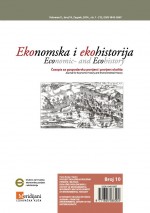ODABRANE TEME IZ PAŠKE POVIJESNE TOPONIMIJE .
SOL , DRVO , VJETAR I VODA : GLAVNE ZNAČAJKE
PAŠKOGA POVIJESNOG OKOLIŠA U SREDNJEM I
RANOME NOVOM VIJEKU
SELECTED TOPICS OF PAG HISTORICAL TOPONYMY . SOL , WOOD , THE WIND AND WATER MAIN FEATURES PAG HISTORIC ENVIRONMENT IN THE MIDDLE AND EARLY MODERN AGE
Author(s): Branimir BrglesSubject(s): Economic history, Human Ecology, Environmental interactions
Published by: Društvo za hrvatsku ekonomsku povijest i ekohistoriju - Izdavačka kuća Meridijani
Keywords: environmental history; island of Pag; historical toponymy; deforestation in history;
Summary/Abstract: Analisyng the historical attestations of toponyms on the island of Pag, and using a interdisciplinary approach, the author is concerned with historical relations of the islanders with their environment. By using a wide variety of interdisciplinary methods and approaches of history, onomastics, archeology, geography and other related sciencies and humanities concerned with the historical environment, it is possible to satisfactingly explore how the inhabitants relate to and interact with the natural world around them. The main purpose of the research is to point out the environmental features of the island of Pag in medieval and early modern times. The methodology used involved historical attestations of Pag’s toponymy aswell as closely analised historical kontext and relations between the people of Pag and their environment. Mostly by using the histotrical sources, and (on a smaller scale) fieldwork, the author has allocated several important environmental features which had immense impact on the historical development of the island of Pag. Firstly, one must mention sea salt, the most important medieval and early modern export product. Shipbuilding, seamanship and maritime trade are very important economic activities in the history and economy of every island. The historical sources and attestations of toponyms validate these assumptions. In historical sources one can find numerous toponyms whose motivation for naming we can relate to woods, forest, or shrubs. The question is: was the island of Pag in medieval and early modern times covered with rich forests, or do the numerous toponyms whose naming motivation we connect to woods and forests prove otherwise? Another important feature of the island of Pag is bura. Bura is a cold, northernly wind which often bring salty rain and even snow. Many toponyms on the island of Pag were motivated by it. Doubtlesly, bura is the most important natural facilitator of deforestation. The last feature that is being depicted in the article is water. Modern geographical and geological research showed us that one could fing fresh water springs, puddles, and other refferents connected with water all over Pag. Once again the historical attestations confirmed the hypothesis, together with geological data, forcing us to conclude that the island of Pag had always been rich with fresh water.
Journal: Ekonomska i ekohistorija - Časopis za gospodarsku povijest i povijest okoliša
- Issue Year: 2014
- Issue No: 10
- Page Range: 189-198
- Page Count: 10
- Language: Croatian

